Parameters and Variables for Research Purposes
-
Intro
-
Parametric model
-
Familiarize with parameters, variables, constraints.
-
Selecting parameters and variables
-
Conclusion
-
Useful links
Information
| Primary software used | Grasshopper |
| Course | BKB3WV4 – Bouwkunde als wetenschap |
| Primary subject | AI & ML |
| Secondary subject | Optimization |
| Level | Intermediate |
| Last updated | November 12, 2025 |
| Keywords |
Responsible
| Teachers | |
| Faculty |
Parameters and Variables for Research Purposes 0/5
Parameters and Variables for Research Purposes
Explanation on how to set parameters, variables, and constraints for a parametric model to be used for optimization purposes.
This tutorial is an EXERCISE.
It is part of a line of tutorials about the use of parametric modelling, simulations and optimisation in research at BSc level. The overall line uses parametric modelling, simulations, and optimisation to generate data to support research investigations (to support answering a research question). This tutorial focuses on how to select and set parameters, variables, and constraints when building a parametric model to support a research / answer a research question. This tutorial can be followed as stand-alone tutorial or as part of the BK3WV4 course (BSc course). If you are attending the course BK3WV4, please practice the exercise in this tutorial in preparation to the workshop ‘parametric modelling’.
Before doing the exercise, be sure you have understood the terminology. Do you remember what parameters, variables, and constraints are? Here you can refresh background information if you need:
Remember also that developing a parametric model to answer a research question requires a mindset different from developing a parametric model to explore design options during a design process. When you develop a parametric model to investigate design options in a design process, it is likely you target goals that are meaningful for your design brief. For example, if you are designing a high-rise, it is likely you may focus your parametric model on design options of tall buildings. When you develop a parametric model to answer a research question, you may focus on broader ranges of parameters to extract knowledge applicable in general cases. For example, you may be interested in comparing the performance of low-rise versus high-rise buildings for certain criteria, e.g. “energy efficiency”. These differences imply that parameters, variables, and constraints may be set differently in your parametric model. If you would like to refresh more background information about parametric modelling for research, you can do it here:
Now that you feel confident about the background information, let’s move on with the EXERCISE. This tutorial will use an example: a room with a window on its exterior wall.

Parameters and Variables for Research Purposes 1/5
Parametric modellink copied
In this tutorial, we will use a parametric model (a grasshopper definition) of a room with a window on its exterior wall. We will use this parametric model to reflect on different possible parameters, variables, and constraints of the same geometry (of the same room, façade panels, and window).
A room with a window on its exterior wall can be modelled parametrically by setting different parameters, variables, and constraints. Parameters, variables, and constraints depending on what you want to investigate with your parametric model. The parameters, variables, and constraints must be set according to the research question you want to answer. Setting them appropriately is important to prevent obtaining invalid or misleading results in your research. During this tutorial you will select your own parameters, variables, and constraints, depending on your research question.
The example we use in this tutorial is a quadrilateral room with façade panels and a quadrilateral window on its exterior wall. If you develop a parametric model of a room with façade panels and a window on its exterior wall, are the room’s length and width fix parameters or variables? Are the window’s length, width and position fix parameters or variables? If the length and/or width of the room and/or of the window are variable, can they change in any way or do they have to change according to certain constraint?
For example, can the room have any proportion of should the model be limited to a certain ratio between length and width? Can the window have any proportion, or should the model be limited to a certain ratio between its length and width? If the position of the window can change, can it change to any position or can it change only to certain positions on the façade? Why?
Exercise file
In this tutorial, we do not explain how to develop the entire Grasshopper definition of the model. In this tutorial we assume you are already able to work in Grasshopper and we use a Grasshopper definition already made. You can download the exercise file here:
Parameters and Variables for Research Purposes 2/5
Familiarize with parameters, variables, constraints.link copied
In this part of the tutorial, we look at various geometric features for you to reflect on their meaning in terms of parameters, variables, and constraints. This step is for you to familiarise with the concept.
Room size
In a parametric model of a room with façade panels and a window on its exterior wall, the room dimensions can be fixed parameters or variables. In some cases, you want them to be fixed. In some cases, you want them to be variable.
Assume you are conducting research on the influence of the room dimensions on the distribution of daylight. You can use the parametric model to generate several different variations of the room dimensions and check how the daylight distribution changes.
To do so, you may want the room dimensions to be variables. If you want to investigate the effect of different window dimensions on the distribution of daylight within a given room, then you may want to keep the room dimensions fixed. If you want to investigate the effect of the windows and room dimensions on the distribution of daylight in a typical Dutch dwelling, you may want both the room and window’s dimensions to be variables. On the other hand, because you are investigating typical Dutch dwelling, you may not want to include rooms’ hights of 4 or 6 meters, as they are outside the range of typical Dutch dwelling (which have an average room height is around 2.6 meters).
In this case, you may want to constrain the height to be below a certain maximum. Choosing the right constraints is key for your research outcome. A room height of 4 meters is not very representative when your research covers ‘standard’ dwelling rooms.
However, the room height in monumental buildings could be higher than 3 meters. For research into office spaces, there could be other averages or requirements for room dimensions.
Window size and placement:
In a parametric model of a room with façade panels and a window on its exterior wall, the window’s size and position can be fixed parameters or variables. In some cases, you want them to be fixed.
In some cases, you want them to be variable. Assume you are investigating the effect of windows’ positions on the view building users see to the outside. You can use the parametric model to generate several different variations of the windows positions and check how the view changes. To do so, you may want the windows positions to be variables.
Assume you are investigating the effect of window positions and proportions on the view of the outdoor and indoor daylight. You can use the parametric model to generate several different variations of the windows positions and proportions and check how the view and daylight changes. To do so, you may want the windows size and positions to be variables – but you may also want the windows size to change according to certain proportions. A window size could be adjustable in either one or two directions (width and height), which could happen interconnected or in respect with each other.
The latter means that the width-to-height ratio is a constant parameter. Alternatively, the window percentage could be a variable with the width as adjustment point and the window height as fixed parameter. Lastly, while defining the window placement in the façade it is important to understand that parameters, variables and constrains directly affect each other. The constraints of the window dimensions have a direct relation with the façade dimensions, as a 4-meter-high window in a 3-meter-high room is (often) not possible.
The exact placement of the window in the façade could be set as a parameter, for example the window will be placed in the middle of the façade. This means that the distance between the endpoint of the façade and the start of the window changes as the width of the window changes.
Try it yourself
The current exercise script is not optimized. It has two options of window placement and the parameters, variables and constraints are not set.
Try for yourself what happens if you change the sliders, try all different combinations, see what works and what doesn’t. Do you see that the current domains of the sliders are not set correctly and result in incorrect geometry creation. Additionally, there must be decisions made on which design aspects become parameters and which become variables. This limits the possible design options and gives a clear path on how to set the constraints of the variables.
Let’s dive into this together. Start with both window positions in the middle. For a room with a width of 6 meters, you can start with the following settings for the window:
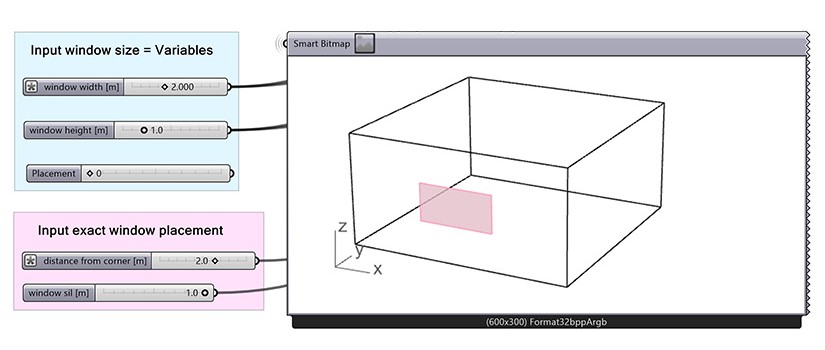
- Room width & depth = 6m
- Room height = 3m
- Window width 3m
- Window height 2m
- Placement 0 = middle
- Distance corner = 1.5m
- Window sill – 0.5m
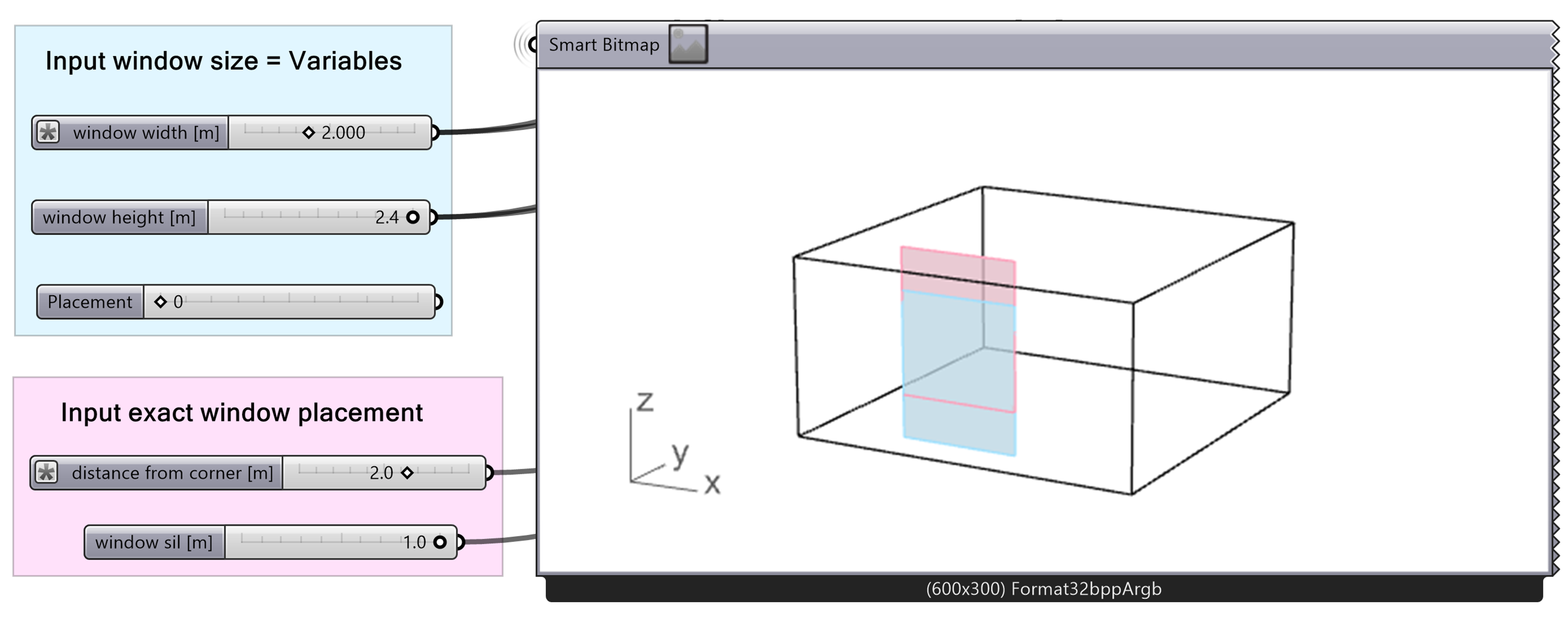
Now start by changing the window height. Do you see that the blue window stays in the middle while the pink window increases upwards. Additionally, making a 2.5m high window works for the blue window but not for the pink window. The variable constraint is dependent on the parameter you set.
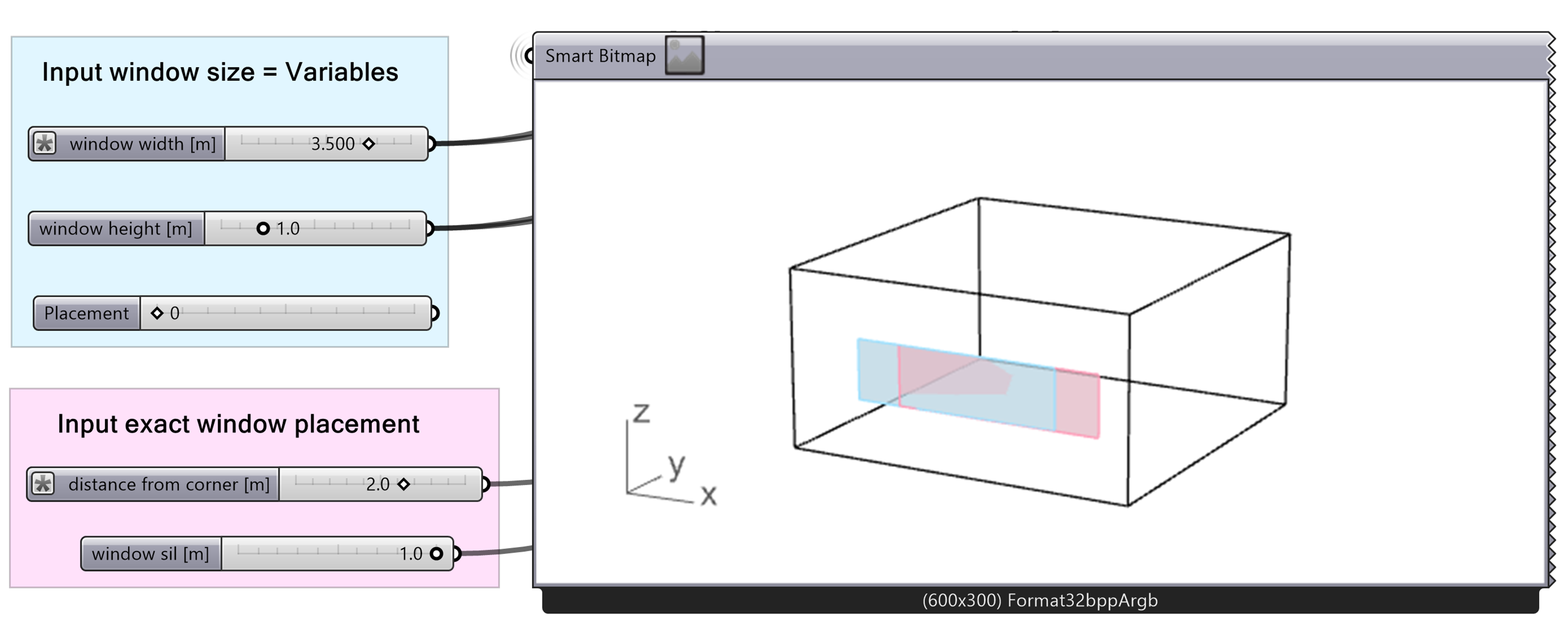
Now change the window hight back to 1m and start changing the window width. The same thing happens when increasing the window width, the pin window increases on the right side, while the blue window increases in both directions.

Now change the window settings back to the original settings as mentioned above. Start changing the room dimensions this time. Do you see that with the current settings you can create windows that are completely outside the room geometry if you start decreasing the room dimensions. We call this invalid design options. While running an optimization or automated simulation process, you want to ensure no invalid design options can be created before running the model.
Examples
To be concrete, here are some examples on the selection of parameters and variables selection. Remember, these are simplified examples just for you to grasp the overall principles.
- How does the placement and size of a window on a façade influence the daylight quality in a given studio apartment?
- Parameters: room size
- Variables: window size, window placement
- Constraints: minimum and maximum window size, number of window placement options
- How can the room depth along with the size and number of windows influence the daylight quality in an apartment?
- Parameters: room height, room width
- Variables: number of windows, window size, room depth
- Constraints: minimum and maximum: window size, number of windows, and room depth
- How can the allocation and size of the windows influence solar/heat gains in an apartment with a given layout
- Parameters: room size
- Variables: allocation of windows on different sides, window size
- Constraints: which side of the room the window is on (orientation), minimum and maximum window size, where window is located on the wall (left, right, center)
- How many windows are needed to ensure that an given apartment gets the maximum daylight hours?
- Parameters: window size, room size
- Variables: allocation of windows, number of windows
- Constraints: sides/faces to allocate windows, where it is located on the wall (left, side, centre), the minimum and maximum number of windows
Parameters and Variables for Research Purposes 3/5
Selecting parameters and variableslink copied
The previous steps of this tutorial have let you familiarise with the overall principles. This part of the tutorial will guide you through some practical examples. Open the exercise file for this part. We are going to make parametric form generation for a research question. Remember, there is not one right answer to this, the right selection of parameters, variables and constraints depends on the research question, research objective and research boundaries you set.
- Which window parameters have the highest impact on the production footprint of a façade for a residential studio apartment design, while remaining adequate lighting.
- Parameters: room dimensions
- Variables: window size, window placement
- Constraints: minimum, and maximum window size, number of window placement options
- What is the most effective combination of grid parameters that can lead to minimized production footprint of a façade for a residential studio apartment design, while remaining adequate lighting.
- Parameters: window size, window placement
- Variables: room dimensions
- Constraints: minimum, and maximum room size
You can select one of the two below for yourself. This tutorial will show option one. Do you want to challenge yourself? Go for the other option, or change the dimensions and make the geometry work.
Note: From here on the exercise will create adjust the parametric model by selecting the right parameters, variables and constraints, so the first question can be answered.
Parameters
Design aspects influencing the room dimensions such as width, length, and height, are left as parameters; we do not change them in this optimisation exercise. Another design aspect left unchanged is the distance of the window placement point from the wall edges (“Window-Facade spacing [m]”). Within the optimization problem we do now want to investigate those design aspects. It could be that those design aspects are given by the design brief or in terms of research are the boundary conditions or fixed aspects that are not included in the investigation. For example, for research the selected room dimensions should have come from literature study or a selected case study. Or in this case, the size of the room fall within the boundary conditions of the research, as it only focusses on a studio apartment.
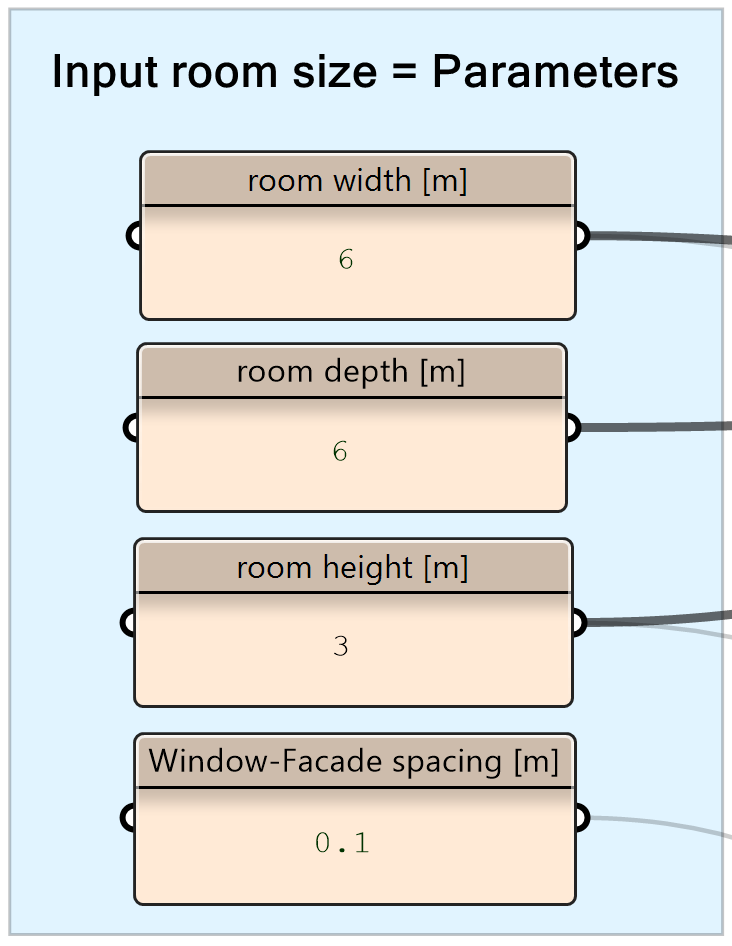
Ensure those design aspects in the Grasshopper scripts are put in panels, indicating unchangeable values. Follow these design criteria:
- Room width = 6m
- Room depth = 6m
- Room height = 3m
- Window-façade spacing = 0.1m
- Create panels for the parameters.
Variables and constraints
The variables – design aspects to be changed during the optimisation process – are in this case “input window size”. In total there are 3 variables that can be changed during the optimization to create new design options. The window width, height and placement. During the geometry design, there are 9 possible window placement options defined in the grasshopper definition. So in this case, a slider of integers and a domain of 0 to 8.
The domains of the variables are the constraints.
|
Variable |
Slider domain |
Step size |
|
Window width |
0.5 – 4.5 m |
0.25 m |
|
Window height |
0.6 – 2.4 m |
0.1 m |
|
Window placement |
0 – 8 |
1 |
The variables should be created with sliders and will be later connected to the WallaceiX component. The window height and placement can be defined by normal sliders. For the window width, we want to create a step size of 0.25 meters, to do this we would have to create a multiplication on the slider. Not including a larger the step size for the window width leads to a larger amount of design options, which in this case are not necessarily needed to draw conclusions.
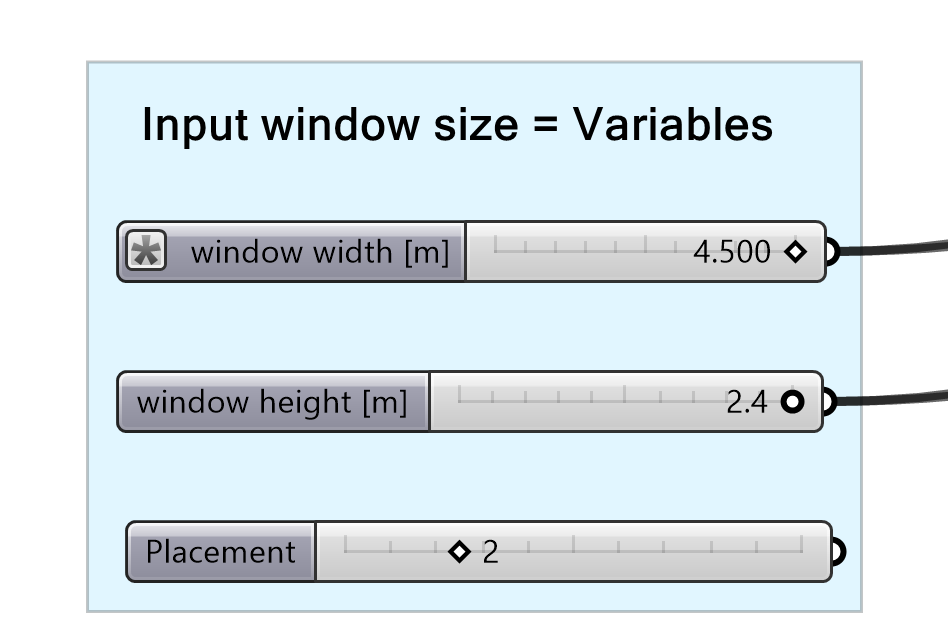
- Change the sliders of window height and placement to the right domain.
- Open the slider settings of the slider ‘window width’ and add the expression below:
- Change the domain of the slider ‘window width’ to 2-18 which after the equation corresponds with a domain of 0.5-4.5.
Checking
Before continuing to the next steps, go back for a moment and check if all the settings are right. Are the parameters, variables and constraints in line with the research question and objective? Are all possible combination of the sliders correct, in other words, are there no geometrical errors generated. Double checking this at the beginning of the process will help you later on, and result in a cleaner and better dataset.
Parameters and Variables for Research Purposes 4/5
Conclusionlink copied
You generated a room with one window in the façade which is ready to run an automated process. By setting the parameters, variables and constraints correctly the created design options are now all valid. This is the first but important step of preparing a model for an optimization or automated simulation process.
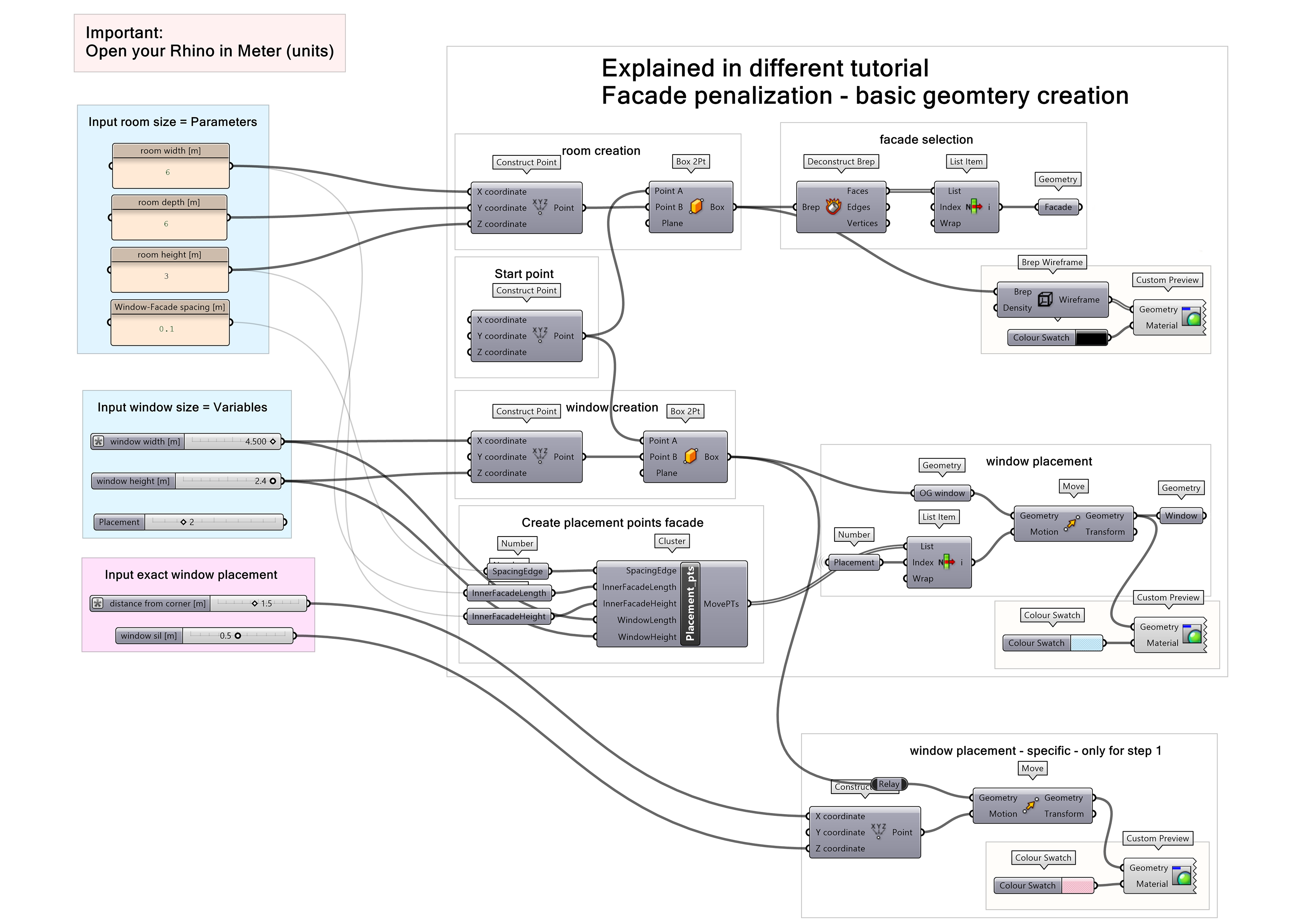
Exercise file
Here you can download the final exercise file. In this file you will find the parametric room set-up to answer the research question explained in the example.
Parameters and Variables for Research Purposes 5/5
Useful linkslink copied
Linked tutorials
If you want to know more background information about the basic optimization terminology you check the page on subjects and definition on optimization. As mentioned before, this exercise is part of a workshop from the BK3WV4 course, you can find the workshop details below.
Follow up tutorials on Optimization with Wallacei
The next step in preparing your model for an optimization or automated simulation process is to select and prepare the objectives. You can learn more about selecting objectives and running the optimization model by first following the Wallacei basics tutorial and then follow the example exercise which uses the same room and research question:
Other useful links
Write your feedback.
Write your feedback on "Parameters and Variables for Research Purposes"".
If you're providing a specific feedback to a part of the chapter, mention which part (text, image, or video) that you have specific feedback for."Thank your for your feedback.
Your feedback has been submitted successfully and is now awaiting review. We appreciate your input and will ensure it aligns with our guidelines before it’s published.
